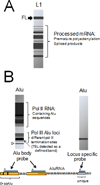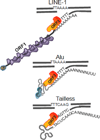LINEs, SINEs and other retroelements: do birds of a feather flock together?
- PMID: 22201808
- PMCID: PMC3364521
- DOI: 10.2741/3991
LINEs, SINEs and other retroelements: do birds of a feather flock together?
Abstract
Mobile elements account for almost half of the mass of the human genome. Only the retroelements from the non-LTR (long terminal repeat) retrotransposon family, which include the LINE-1 (L1) and its non-autonomous partners, are currently active and contributing to new insertions. Although these elements seem to share the same basic amplification mechanism, the activity and success of the different types of retroelements varies. For example, Alu-induced mutagenesis is responsible for the majority of the documented instances of human disease induced by insertion of retroelements. Using copy number in mammals as an indicator, some SINEs have been vastly more successful than other retroelements, such as the retropseudogenes and even L1, likely due to differences in post-insertion selection and ability to overcome cellular controls. SINE and LINE integration can be differentially influenced by cellular factors, indicating some differences between in their amplification mechanisms. We focus on the known aspects of this group of retroelements and highlight their similarities and differences that may significantly influence their biological impact.
Figures




References
-
- Lander ES, Linton LM, Birren B, Nusbaum C, Zody MC, Baldwin J, Devon K, Dewar K, Doyle M, FitzHugh W, Funke R, Gage D, Harris K, Heaford A, Howland J, Kann L, Lehoczky J, LeVine R, McEwan P, McKernan K, Meldrim J, Mesirov JP, Miranda C, Morris W, Naylor J, Raymond C, Rosetti M, Santos R, Sheridan A, Sougnez C, Stange-Thomann N, Stojanovic N, Subramanian A, Wyman D, Rogers J, Sulston J, Ainscough R, Beck S, Bentley D, Burton J, Clee C, Carter N, Coulson A, Deadman R, Deloukas P, Dunham A, Dunham I, Durbin R, French L, Grafham D, Gregory S, Hubbard T, Humphray S, Hunt A, Jones M, Lloyd C, McMurray A, Matthews L, Mercer S, Milne S, Mullikin JC, Mungall A, Plumb R, Ross M, Shownkeen R, Sims S, Waterston RH, Wilson RK, Hillier LW, McPherson JD, Marra MA, Mardis ER, Fulton LA, Chinwalla AT, Pepin KH, Gish WR, Chissoe SL, Wendl MC, Delehaunty KD, Miner TL, Delehaunty A, Kramer JB, Cook LL, Fulton RS, Johnson DL, Minx PJ, Clifton SW, Hawkins T, Branscomb E, Predki P, Richardson P, Wenning S, Slezak T, Doggett N, Cheng JF, Olsen A, Lucas S, Elkin C, Uberbacher E, Frazier M. Initial sequencing and analysis of the human genome. Nature. 2001;409:860–921. - PubMed
-
- Boeke J, Garfinkel DJ, Styles CA, Fink CR. Ty elements transpose through an RNA intermediate. Cell. 1985;40:491–500. - PubMed
Publication types
MeSH terms
Grants and funding
LinkOut - more resources
Full Text Sources

